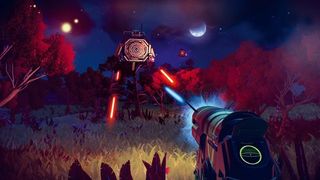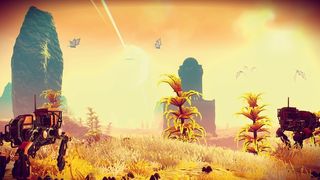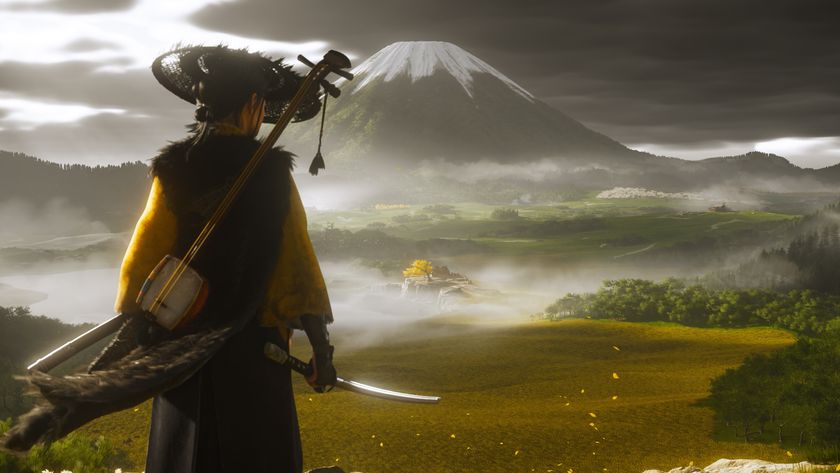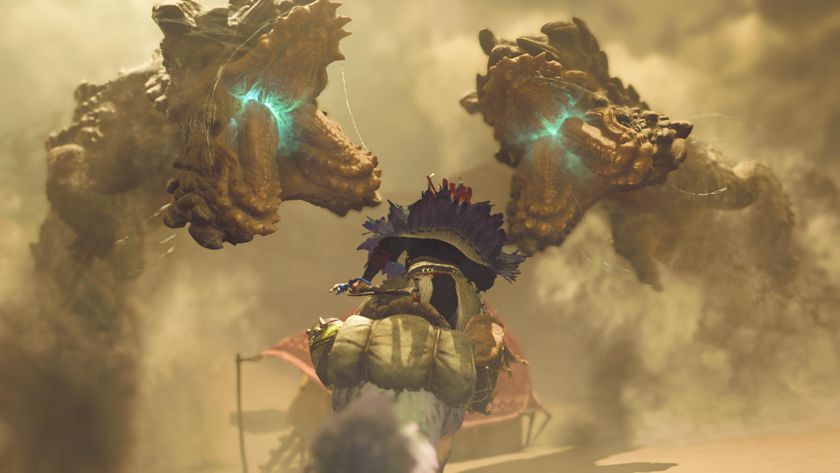No Man's Sky sheds light on the dark side of what you can do in its vast universe
Embarrassingly, we’ve only just landed on a new world and already we’ve misplaced our ship. “It’s a ballache; I like that,” says Hello Games managing director Sean Murray when we crack and ask if there’s a faster way to return to our craft in No Man's Sky. “I have this [design] argument with the guys all the time, but if I hand someone the controller, the first thing they’ll do is lose their ship. Even in games like Far Cry 4, Dragon Age or The Elder Scrolls 4: Oblivion, which are huge worlds, there are pathways. They want me to go this way to get some plant at the top of a mountain, but I prefer to go this way, and I’ll just buggily hop up. We don’t have those predefined pathways.”

That’s partly down to the fact that hand-carving lanes into 18,446,744,073,709,551,616 planets would put No Man’s Sky’s release date beyond the lifespans of the current team, but Hello Games isn’t looking into procedurally generating paths either. “It’s really fun to watch, because people spend their first half hour with the game getting lost – hopefully in a good way,” says Murray. “Then you see something: suddenly they start treating it as a real place, using landmarks [to navigate]. They’ll say, ‘Oh, I’m at the other side of that lake now.’ They’ll land their ship and say, ‘I’m leaving my ship by those trees,’ remembering places like that to find their way back. That’s quite a nice thing.”
If only we’d planned before bounding off into the unknown. When we do find our way back to the spaceship (which, mortifyingly, turns out to be only 40 or so metres away), our immediate impulse is to continue exploring, so we burst up through the atmosphere and then hold Circle to gad about the solar system at interplanetary speeds. Such a nomadic lifestyle is all very well, but Hello Games hasn’t been particularly vocal on what you can do when you reach a new location. Quite a lot, it turns out.
Unsurprisingly, exploration forms the backbone of the game. You can turn your intrepid wanderings into profit by cataloguing the planets and creatures you encounter, and then uploading that information to a network called Atlas via beacons found on every globe. Everything you find gradually builds up a massive personal encyclopedia, too, but discovery matters: if somebody else happens to land on a planet you’ve already visited and tries to upload the details of a creature that you identified first, the name you chose for it will be imposed upon their database. Naming an ugly creature after one of your enemies, then, is a convoluted – and mathematically improbable – way to get one over on them.

“A lot of people will share those discoveries,” says Murray. “Not just by uploading them [at beacons], but by actually pressing the Share button, or uploading to YouTube, or creating little animated GIFs of the specimens that they’ve found, because you do find some weird, hilarious creatures.”
Conservation and classification don’t have to feature at the top of your list of priorities, however. Earlier on in our demo, Murray reluctantly executes a bipedal leporidae-like – “I hate doing this, because I’m a hippy” – to demonstrate the consequences. A floating drone floats into view and attacks, and as Murray continues to slaughter the local fauna, the number of bots increases. A wanted level fills as the situation worsens, and eventually the game summons towering walking drones to the fray. Destroying any drone makes you money, so if your equipment’s good and you aren’t ecologically minded, you can rampage your way across galaxies without bothering to contribute to the collective encyclopedia. Murray’s rage isn’t sufficient, however, and he succumbs to a barrage of lasers.
The gun you carry is more than just a weapon, handling scanning and mining duties alongside the potential for catalysing mass extinction events. It can be upgraded by adding alien technologies (which you’ll discover and combine throughout your travels) to a grid menu that represents the tool’s innards, and placing similar techs next to each other offers further performance boosts. Your scanner, for example, starts out as a short-range directed beam, but with the right tech can become a wide-reaching pulse that emanates out from you. The improved scanner can also detect resources buried beneath the surface or in rocks, and you can then use your laser to mine them.
Sign up to the GamesRadar+ Newsletter
Weekly digests, tales from the communities you love, and more

“In a lot of sci-fi games, all their weapons are basically AK-47s with some red stripes down the side,” Murray says. “We don’t like that; we want something that feels advanced and cool. So you have this multitool, which is a little bit like a tricorder.”
Your ship can be upgraded in a similar manner to your multitool, and you can take your activities offworld, too, picking sides in the space battles that will erupt across the universe, bringing a certain brand of justice to pirates, mining asteroids, or trading at the space stations that ferry goods back and forth from trading posts found on planet surfaces. If you’d prefer to put down roots, you could theoretically spend all of your time exploring, mining and trading from just a single planet (every example being “planet-sized”, Murray stresses). All told, there’s a lot more to do in No Man’s Sky’s unfathomably large universe than early demos suggested.
Another aspect that hasn’t been discussed in detail before are the various day/night cycles that you’ll encounter on each strange new world. Seeing the night make its way across the surface of a sphere as you descend into its atmosphere for the first time is a stirring sight. We head into the dark to land, and Murray apologises in advance – it’s Sod’s law, he says, that this unexplored planet will “look ugly” when we touch down. He couldn’t be more wrong.

The darkness encourages new creatures onto the blue-tinged savannah and the grass sways in the soft light of a sky-filling moon. You can be as industrious as you like in No Man’s Sky, it turns out, but your strongest memories are likely to be forged in the moments when you do nothing and just take it all in.
Read more from Edge here. Or take advantage of our subscription offers for print and digital editions.
Edge magazine was launched in 1993 with a mission to dig deep into the inner workings of the international videogame industry, quickly building a reputation for next-level analysis, features, interviews and reviews that holds fast nearly 30 years on.













